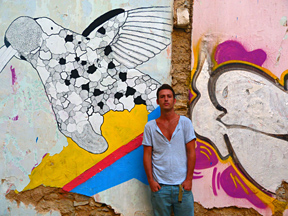Greek graffiti has been vibrant for 30 years, but spiked in 2008 after the shooting death of 15-year-old Alexis Grigoropoulos in the anarchist-artist neighborhood hotbed of Exarchia. Many buildings have been touched by graffiti to make some a statement and cover the dirty, grey concrete buildings in a desperate bid to create some charm.
There are amateurs scribbling with spray paint, taggers who want to make a name for themselves while remaining anonymous and genuine street artists who don’t want to be identified, such as Bleeps.gr, who said he lived in Bristol, England, the home of that country’s celebrated street artist Banksy. There’s also Vaggelis Hoursoglou, who uses the street name Woozy; Absent and Animouz, each with a distinctive style, trying to make portraits of life as they see it.
Their work is next to those of other renowned street artists, such as Alexandros Vasmoulakis, who covers entire walls with abstract avenge-garde expression; the Dali-like surrealism of Dimitris Taxis showing a boy chained around the neck to a heavy weight of debt; Hope, whose work made it into a public exhibition.
Greek graffiti is a curious mix of caustic slogans and swirling art, using walls as a canvas for artistic expression. But now, after the death of Grigoropoulos and two years into a crushing economic crisis that has seen many Greeks buried under pay cuts, tax hikes and slashed pensions, street artists are taking out their fury with biting political graffiti.
It’s a curious selection of satire and black humor, phrases in Greek such as Their Wealth is Our Blood scrawled on a concrete wall across from a McDonald’s, and more profane messages replacing gentler wall protests, Burn Parliament a common refrain. Hoursoglou told Southeast European Times there’s a reason artists prefer the streets to museums. “Graffiti itself is a political message,” he said. “If there is no political message, this form of art misses some of its essence which is not only creating a fancy, eye-catching image but mostly pointing out modern social problems and envisioning a possible change,” he said.
Alex Kataras, 31, a self-styled street artist in Exarchia, said his forte is not politics, but said he understands what led to it. “I follow politics and street art is more politically-based,” he told SETimes. While some critics decry what they say is destruction of private property, Kataras said, “I don’t think it’s vandalism. It’s a form of art. It makes buildings more colorful and political graffiti has more meaning.”
In a people’s park in of Exarchia, a vacant lot turned into a leafy brocade of makeshift benches, dirt pathways and zen-like garden patches, a place where students and workers are comfortable, Despoina Stefoudi, 20, sits with two girlfriends, across the street from a building whose side was covered with political graffiti.
“Political graffiti is right, it’s a way to express indignation,” she told SETimes. Her friend Maria Vandolou, also 20, said graffiti had an advantage over museum art. “When it’s on a wall, everyone can see it,” she told SETimes.
To see a slide show of Greek graffiti, visit:
http://www.setimes.com/cocoon/setimes/xhtml/en_GB/features/setimes/features/2012/08/31/feature-02
(Reprinted by permission of Southeast European Times (www.setimes.com)
See all the latest news from Greece and the world at Greekreporter.com. Contact our newsroom to report an update or send your story, photos and videos. Follow GR on Google News and subscribe here to our daily email!




